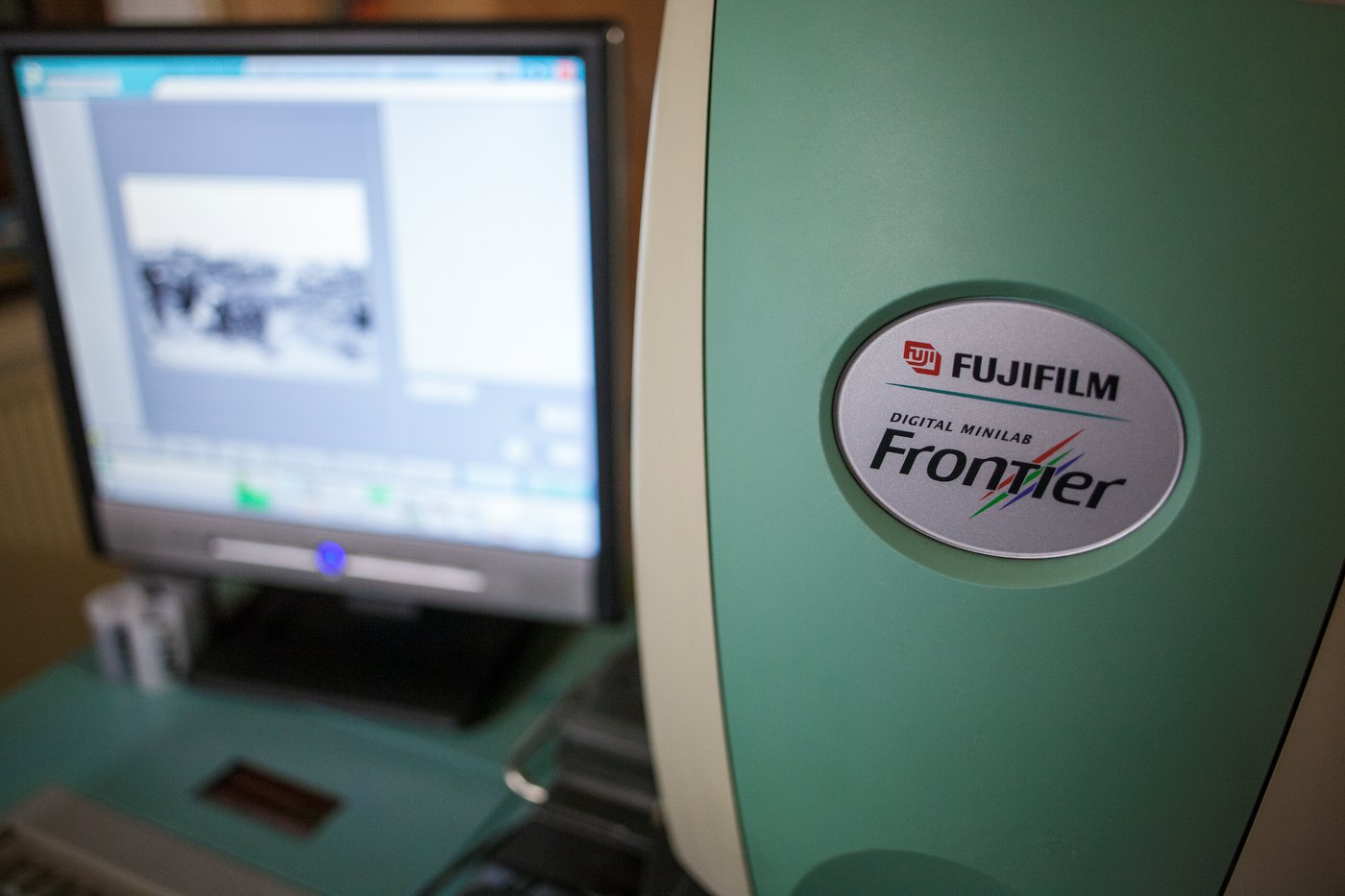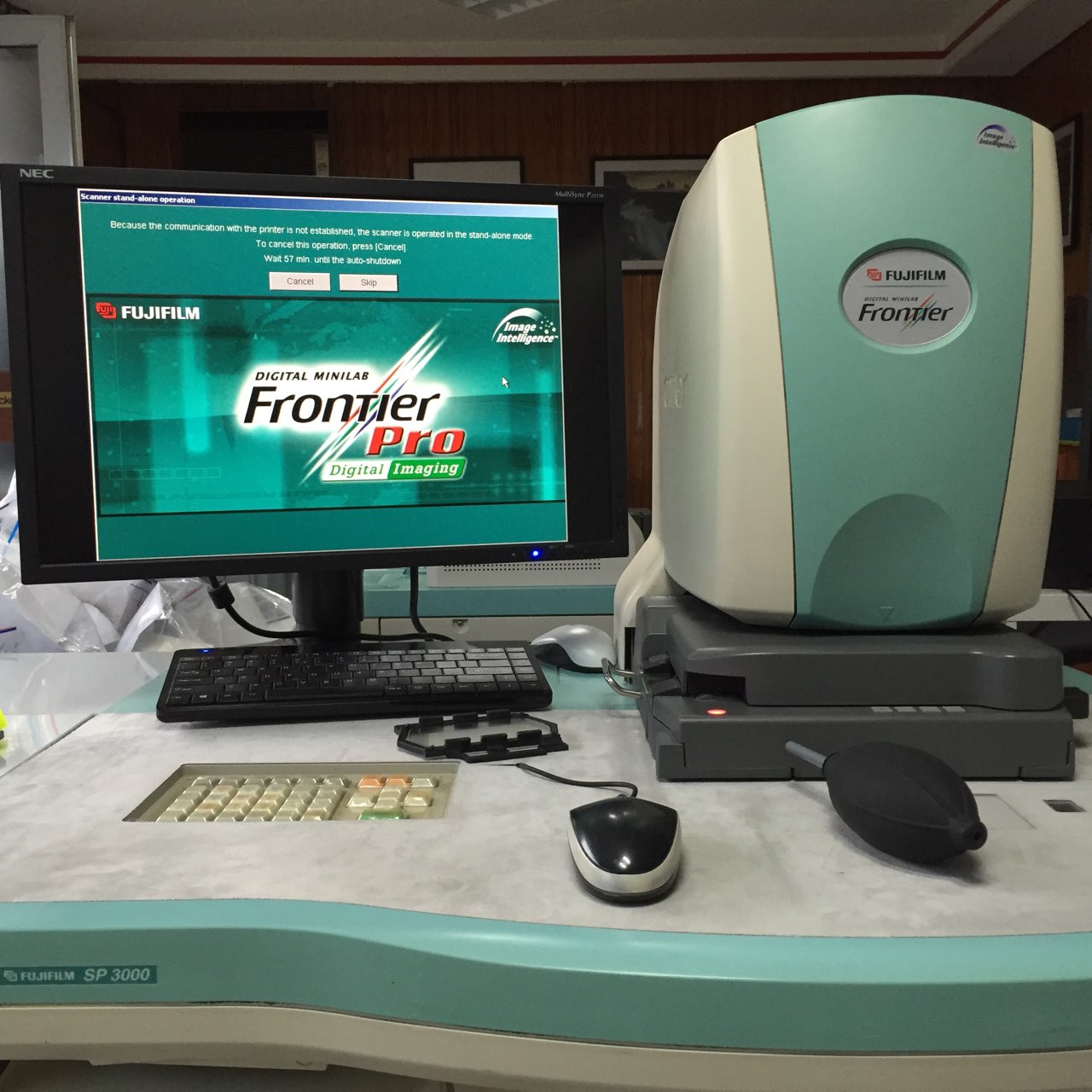A not really objective verdict
On March 18th the article What’s With All the Poor Negative Film Reviews? by Brad Nichol was published on petaxpixel.com and I not only fully support his point of view, I would also like to use it as a starting point for an very personal tribute to a single piece of hardware that makes the hard task of scanning easier and let´s you learn how color negative film can look like.
When I first saw scans from a Frontier Scanner, I was immediately hooked. I never saw something more sweet or more compelling. Negatives that have been scanned by this machine have something magical. In my eyes the Fuji Frontier, although it is unfortunately not produced anymore, has done more to the renaissance of film than any other medium, camera or other equipment. The popular look that so many of us analog photographers want to achieve is often only possible with a good scanner and I do know that there are alternatives to the Fuji Frontier, but the true magic can hardly be matched. The Frontier retains the full dynamic range which is captured on the film and the difficult contrast expansion is done so well that it adds just the right amount of mid tone contrast in almost any kind of light situation. This gives us the feel of a real photograph while holding all the valuable color information. Skin tones look super natural and the highlights sing!
Image courtesy of MeinFilmLab.de
So where does this magic come from? The RA4 process that is required to develop analog color paper is cumbersome and requires processing in full darkness. It is very temperature critical similar to C-41. Making great color prints in the darkroom is almost a lost craft that only a view really good printers are still able to do. The simple answer to this problem is scanning and Fuji has made a whole production line to help Minilabs to deliver fast and easy prints to all those customers who want their film developed and processed in less than an hour. With the advent of digital those mini labs started to disappear. The demand of paper prints declined and the machines were sold or demolished. Today the SP-3000 is again getting more and more attention. It is the scanner part of the production line and it is capable of making awesome digital files. I would say that the Fuji Frontier is maybe making the best straight scans from color negative film availability today.
But hey, what about all these fantastic drum scanners and highly acclaimed Hasselblad Flextight scanners? Good question! I would not at all argue that these scanners are less than stunning and they are fantastic when it comes to resolve the smallest detail on your film. You will not get the same detail reproduction from a Fuji Frontier than from a virtual drum scanner! The magic is hidden in another detail and this is how the Frontier works. Drum scanners have been designed to work with slide film primarily. They can of course be used for any other kind of film and they will do a great job. However the light source and the filter mechanism of the Frontier scanner is originally designed for working with color negative film. What this means is that the scanner operator has nearly the same tools as a printer in the darkroom. It is almost like a digital color head of an enlarger. This brings many benefits and the biggest one is that the process is so close to the original design of the color film. All the benefits of color negative film are taken into account: the huge exposure latitude derived from the tonal compression in the negative, the super fine and excellent color reproduction and last but not least the light quality. The engineers of the Frontier managed to combine all this in one machine.
Fuji Frontier
Hasselblad Flextight - no edits
Hasselblad Flextight with Lightroom adjustments to match the Frontier scan
The biggest challenge, the inversion of the image data is done incredibly well straight out of the scanner. Almost no need for further post processing. The Fuji software is taking care of everything and despite the complexity of the problem, the final scan will always look authentic and believable. This sounds much simpler than it really is. Looking at modern consumer scanner, software often struggles with challenging light situation that has been captured on film, either due to high dynamic range, color shifts or dense negatives. The combination of the hardware and the software is the real secret of the Frontier. Unfortunately this is one reason why this machine is not really designed for home users. Quite some calibration and maintenance effort is required to keep this scanner doing a great job. The easiest way of getting those nice colors and light, is trusting a good lab that does all the hard work for you.
Fuji Frontier
A challenging light situation nicely rendered by the Frontier scanner. Highlight detail is of course at the edge but overall appearance of the scan is very close to how the scene look at this dark morning.
Noritsu
The Noritsu handles the same situation equally well. Colors and contrast show slight variations compared to the Frontier scanner, but overall both scans render the scene nicely. The quality of highlight detail seems to be a bit better in the Frontier scan.
Besides all the praise and glory there is a certain downside, which I would like to mention here. First and foremost the scanner requires a experienced operator that exactly knows how to handle the machine. Second, the resolution of the Fuji Frontier is limited to the size of the CCD sensor that will be shifted by two small actuators. Depending on the amount of shifts we get different final resolutions. As far as I know only a hand full of labs in the world is able to achieve the XXL resolution from this scanner. In terms of numbers this means the highest resolution you will get from a 6x6 negative is 4096x4096px or for a 6x9 negative up to 4096x6144px. This is of course a high number but nothing compared to what a drum scanner can do.
So are these limiting factors? The answer to the first problem is easy, trust a professional and well acclaimed lab. The second aspect is a little bit more difficult and requires some considerations to take into account. The public discussion about resolution and megapixel almost always neglects one very important aspect and this is pixel quality! And in terms of pixel quality you will get super nice and clean jpegs from the Fuji Frontier that can easily printed big. With some tender love and care to the digital file you can easily achieve prints of a width up to 25 to 30 inch. How often do we really print this big? If you happen to be in the position that you need even bigger prints you can always go ahead and have your negative scanned by a drum scanner or Flextight for an even higher resolution. A experienced photographer will have no problem to match 16bit scans from a Flextight scanner to look similar to Frontier scans. So there is always another option. For me, I super rarely exceed the mentioned print size and this is why I enjoy the beauty and magic of the quality that can be achieved with the magical Fuji Frontier scanner! The biggest benefit of it will be the instant results that make you believe in film again.
There is one last thing to consider and this has to do with artifacts from dust or scratches on the negative. The Fuji Frontier will blow you mind when it comes to infrared recognition of these artifacts. The digital ICE will be able to rescue even the oldest and heavily used negatives that you keep in shoe boxes from the past. I am not kidding, this feature really works well and with only minor exemptions it really does a fantastic job. The algorithm is so good that is will not smear the details or reduces sharpness. Other high end scanners often lack this feature and manual dust spotting will be required.
Fuji Frontier
In this example the midtone contrast of the Frontier scan is a bit harder and the colors more towards magenta. While I really like both scans, again I tend to like the Frontier scan better.
Noritsu
The highlights inside the building are slightly less detailed in the Frontier scan, but here I enjoy the nice rendering of the colors in the sky. Both scanner will provide wonderful scans and it is more or less a matter of taste, which one you prefer over the other.
100% view - Fuji Frontier on the left vs. Noritsu on the right - Obviously the little smaller resolution of the Frontier can be noticed at 100%. Pixel quality in both scans is outstanding. Grain and sharpness is what I would expect from a good and detailed scan.
There is of course another great scanner on the market that is more modern and is capable of doing similar things with your film. This is the Noritsu HS-1800. Another great machine that is super powerful. It even provides you with even higher resolutions of up to 4700x4700px for a 6x6 negative. How does this scanner hold up against the Fuji? I asked Jörg Bergs from MeinFilmLab.de to do scans on both machines in XXL super big size resolution for me to compare them here. Above you have already seen this comparisons. The look and feel of both scans as well as the detail rendering is very similar. It is probably a matter of taste which one of these scans you prefer, but I feel a personal tendency to enjoy the scans from the Fuji a bit more. It is good to at least have a choice!
Finally I would also like to add a word of caution. With very dense negatives some systems are prone of producing artifacts which are known as staircase effect. Long vertical streaks are visible in the final scan. This banding is almost never visible on the Fuji Frontier scanner probably due to its design.
The Fuji Frontier will do amazing things to your negatives in terms of color and tone! Drum Scanners and Flextights are the way to go when really really big prints are required. For all other situations you can choose between the Noritsu and the Frontier whichever you like best. This is part of your creative freedom!








